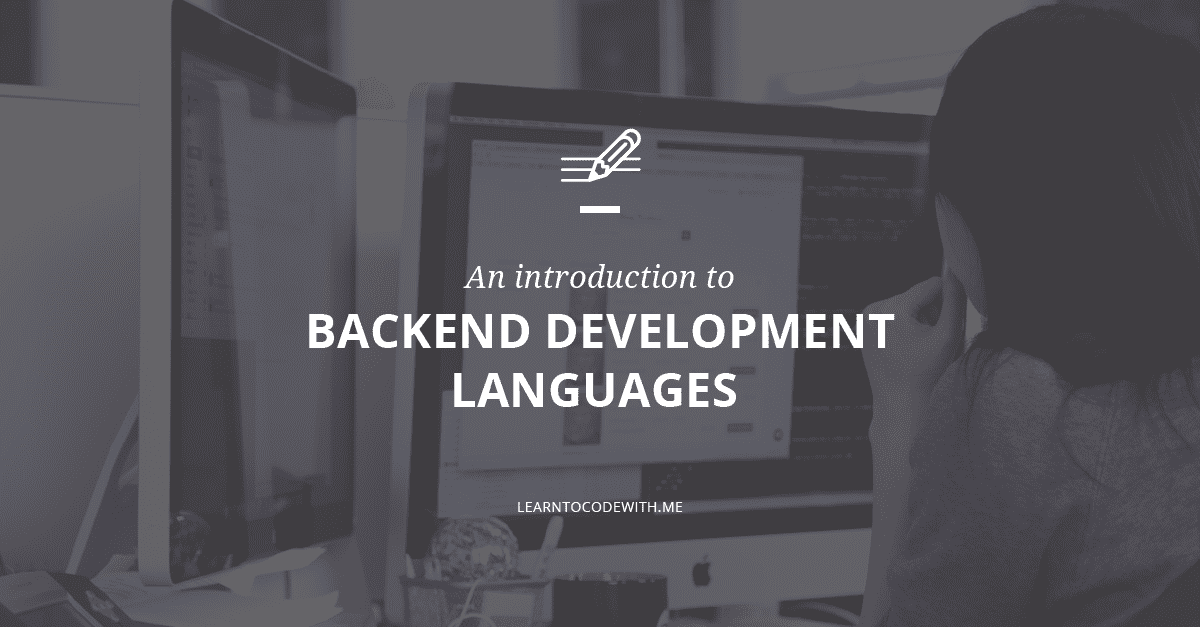Backend development (also stylized as back-end or back end development) is the skill that powers the web. Yet it does it modestly, without fanfare—allowing people to browse their favorite sites without even knowing about all the work put in by the backend developer or team.
So to help dispel this mystery…what is backend development? How do backend technologies work? What are some back end developer languages?
In this special guest post, Krystal Tolani from GoSkills writes about the various types of backend languages, what you can do with them as a backend developer, companies that use them, and (the money question!) what salaries you can earn by specializing in certain backend skills.
Here’s Krystal!
Disclosure: I’m a proud affiliate for some of the resources mentioned in this article. If you buy a product through my links on this page, I may get a small commission for referring you. Thanks!

Backend development languages handle the ‘behind-the-scenes’ functionality of web applications. It’s code that connects the web to a database, manages user connections, and powers the web application itself. Backend development works in tandem with the front end to deliver the final product to the end user.
What Is Back End Development?
What is backend programming/development? As mentioned above, backend development is what keeps the internet running behind the scenes.
Backend developers are primarily focused on how a website works. They write code that focuses on the functionality and logic powering the application they’re working on, and the technology they work on is never directly seen by users.
Backend technologies are a combination of servers, applications, and databases.

Responsibilities of backend programmers could involve writing APIs, writing code to interact with a database, creating libraries, working on business processes and data architecture, and much more. The exact duties of a back end web developer often depend on the specific role and company.
☝️ Back to top
Front-end Vs Backend Programming
Intuitively, the other side of backend development is the front end.
The key difference is that while backend developers build how a website functions, front-end programmers build and design the interface, determining how the site looks to users.
Backend web development lays the foundational code that enables websites to process the actions that users take on the front end and deliver the correct information in return.
Neither works without the other—you need the back end to make the front end work, and you need the front end so people can actually access and interact with the website.
💰 Backend developers typically earn higher salaries than front-end developers, as back end languages tend to be more technical. The average salary for a backend developer is $114,608, while front-end developers earn $100,966.
There are also full-stack developers, who can work with both front-end and backend technologies. They’re the jack-of-all-trades of the programming world.
➡️ Learn more about what’s involved in front-end development in this post.
☝️ Back to top
What Does a Backend Developer Do?
So what does a backend developer actually do in a typical workday?
According to backend developer Ali Bayat from his blog article The Day in the Life of a Backend Developer, “Reflecting on a typical working day, I’d say I spend 50% of my time on project work, 20% in meetings and on general communication, and the remaining 30% working on immediate requests and bugs.”
So, as a back end web developer, you might spend your day doing things like:
- Maintaining legacy applications (older applications that have already been built by other programmers)
- Putting out fires (e.g., bugs, broken applications)
- Attending meetings (to gather requirements for a project
- Collaborate with front end devs on a project, etc.)
- Actually writing code for new applications/projects
So, while you will certainly be coding with back end languages, don’t picture that as being the only thing you’ll do as a back end web developer.
Types of Backend Development Languages
Backend programming can either be object-oriented (OOP) or functional.
OOP is the technique that focuses on the creation of objects. With object-oriented programming, statements should be executed in a particular order. Popular OOP languages are Java, .NET, and Python,
Functional back end programming is a technique that is more “action”-based. Functional programming uses declarative language, which means that statements can be executed in any order. It’s commonly used for data science, and popular languages are SQL, F#, and R.
Back end languages can either be statically typed or dynamically typed. The former is more rigid, but better at catching errors, whereas the latter is more flexible but allows for variables to change types (which could account for unexpected errors). This article by Hacker Noon goes into greater detail if you’re interested in finding out more.
Start coding now
Stop waiting and start learning! Get my 10 tips on teaching yourself how to code.
☝️ Back to top
9 Popular Backend Programming Languages
Now, let’s take a look at some specific backend development languages and what they’re used for.
BACKEND LANGUAGE
KEY INFO
Java
- #3 most popular programming language in the world
- Less beginner-friendly than other backend languages
- Java developers make an average of $100,168/year
PHP
- Powers 78.2% of all websites
- Dynamically typed
- Very forgiving of errors
.NET (C#, VB)
- MVC (Model-View-Controller) architectural pattern
- Can integrate with iOS, Linux, and Android
- Highly stable and reliable
Ruby
- Enables developers to create and launch apps quickly
- Fantastic for prototyping
- Grew in popularity in the early 2000s but has declined since then
Python
- Fastest-growing programming language
- Syntax is simple and easy to understand
- Great for beginners
SQL
- Most common query language
- Used to interact with databases
- Great for beginners
JavaScript
- Can be used for both the front and back end
- Very popular with a large community
- Can be difficult to maintain and scale
TypeScript
- Open source “superset” of JavaScript
- 7th most used programming language
- Developed by Microsoft to simplify JS code
Go
- Statically typed, compiled programming language
- Syntax is similar to C/C++
- Created by Google
Backend Language #1: Java
Java is the #3 most popular programming language in the world—and for good reason. Not only is Java extremely versatile (its use spans from smartphones to smart cards); it has also been used by developers for over 20 years.
What makes Java so versatile is the Java Virtual Machine (JVM). With many back end developer languages, compiling a program creates code that may run differently if the computers it’s run on are different. This is not an issue for Java because of the JVM. The Java Virtual Machine acts like a middle layer that can run code on any computer, regardless of where the said code was compiled.
While Java is extremely popular with desktop and business software developers, it is less beginner-friendly than a backend language like Python. This is because it’s verbose and requires more code to build out features; as a result, Java is less rewarding to those just starting out.
That said, Java’s longstanding popularity and varied use mean that its community is large. Consequently, any questions you may have about this backend language will likely have forum threads and online tutorials dedicated to answering it.
💡 What You Can Do With Java
Java backend technologies can be used to achieve a lot of objectives, including these and more:
- (Android) mobile application development
- Website development
- Database connectivity
- Image processing
- GUI based programs
- Networking
💼 Companies That Use Java
There are some big names among companies that use Java backend technologies, including these:
- Airbnb
- Uber
- Groupon
- eBay
- Evernote
- FitBit
- Hubspot
💵 Average Salary for Java Developers
As of November 2021, Java developers made an average of $100,168/year in the US.
🗺️ Where to Learn Java: The Ultimate Java Mastery Series on Code With Mosh
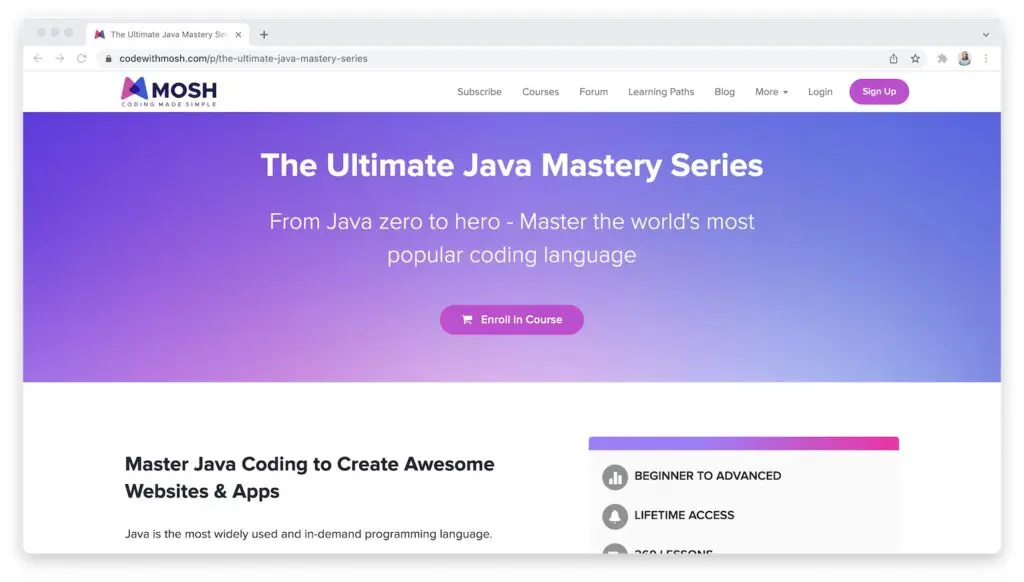
What the course covers: Java, explained clearly from the basics to the advanced concepts. As the course instructor, Mosh, says: “No fluff. No sloppy programming or phoney shortcuts.”
Course facts:
- Course Name: The Ultimate Java Mastery Series
- Platform: Code With Mosh
- Instructed by: Mosh Hamedani
- Price: $147 (or $29/month)
- Skill level: Beginner
☝️ Back to top
Backend Language #2: PHP
PHP powers 78.2% of all websites whose server-side programming language we know. The language was first released in 1995 when there were few options for building dynamic websites.

Since PHP is dynamically typed, it means you’re able to come up with a variety of solutions and workarounds for one problem. It also means that the same bit of code can mean something different depending on the context, which makes programs written in PHP tricky to scale and sometimes slow to run.
PHP is a great language to learn for those who are just starting out for a number of reasons:
- It’s more forgiving of errors, which means that you’re able to compile and run a program until you reach a problematic part.
- There is an abundance of resources dedicated to the language as a result of the large community and tool support. The language undergoes updates, so ensure you’re learning from an up-to-date tutorial.
- The setup is relatively easy compared to a language like Ruby on Rails. You can download MAMP (for Macs) or WAMP (for Windows) and you should be ready to go in 5 minutes.
💡 What You Can Do With PHP
According to the PHP website, you can:
- Collect form data
- Generate dynamic page content
- Send and receive cookies
- Write command line scripting
- Write server-side scripting
- Write desktop applications
💼 Companies That Use PHP 💼
Here are some companies using PHP in their dev teams:
- Lyft
- Mint
- Hootsuite
- Viber
- Buffer
- DocuSign
💵 Average Salary for PHP Developers 💵
As of November 2021, PHP developers made an average of $92,237/year in the US.
🗺️ Where to Learn PHP: Building Web Applications in PHP
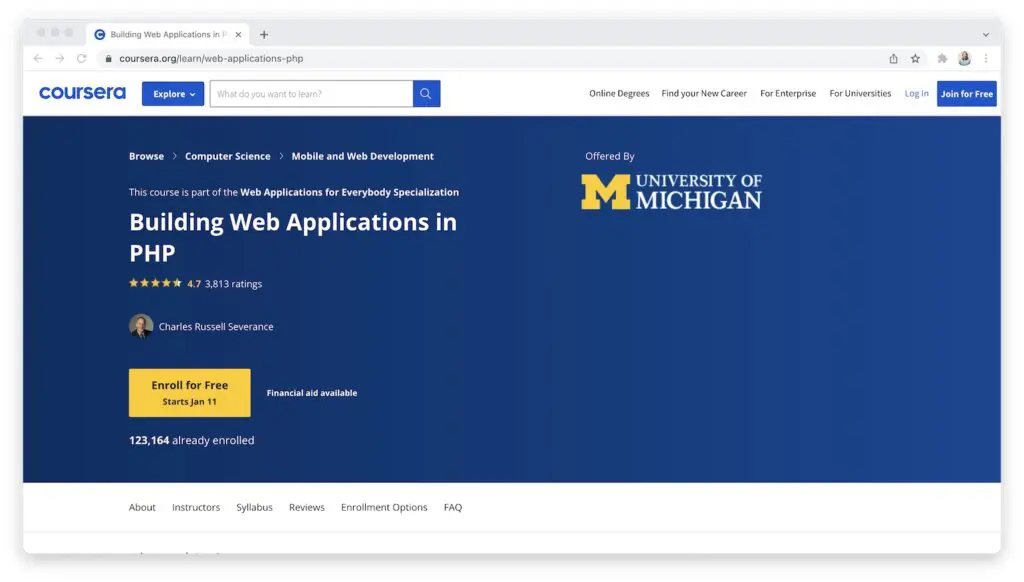
What the course covers: By the end of this series of courses, you’ll be able to build your first PHP websites. Covers PHP arrays and control structures, functions, basic error handling, and more.
Course facts:
- Course Name: Building Web Applications in PHP
- Platform: Coursera
- Instructed by: Charles Russell Severance
- Price: $49/month (or audit for free)
- Skill level: Beginner
☝️ Back to top
Backend Language #3: .NET (C#, VB)
ASP.NET is Microsoft’s answer to Sun Microsystem’s (now, Oracle) Java. The web application framework is used to build backend websites using languages like Visual Basic (VB), C#, F#, and more.
Its MVC (Model-View-Controller) architectural pattern allows backend development duties to be handled by a controller, which interacts with a model to process data. The result is then presented to the view for display as a frontend web page.
Made open source in 2016, .NET can integrate with iOS, Linux, and Android by way of .NET Core. The code is highly stable and reliable, making it a popular choice for businesses. Because it is a Microsoft product, there is great support available if you ever get lost.
C#
C# is a high-level computer language, which means it allows developers to write programs that are independent of a particular type of computer. Languages like these write and read more like human languages rather than machine languages.
C# is popular among developers because it has the power of C++ (another backend language) but is easier to use because it error-proofs commands that tend to trip up C++ users.
Programmers on Stack Overflow have praised the language for its “cool syntax.”
VB
VB is a programming language that uses a graphical user interface (GUI) to modify code written in the BASIC programming language. It’s an easy language to start with because of its straightforward syntax and its widespread use. As a result, it’s often used for prototyping.
The drawback of backend coding with VB is the large amount of memory required to install and run GUI-based development tools.
💡 What You Can Do With .NET
- Build desktop applications
- Create mobile apps
- Build web applications and games
- Work with Big Data
- And more
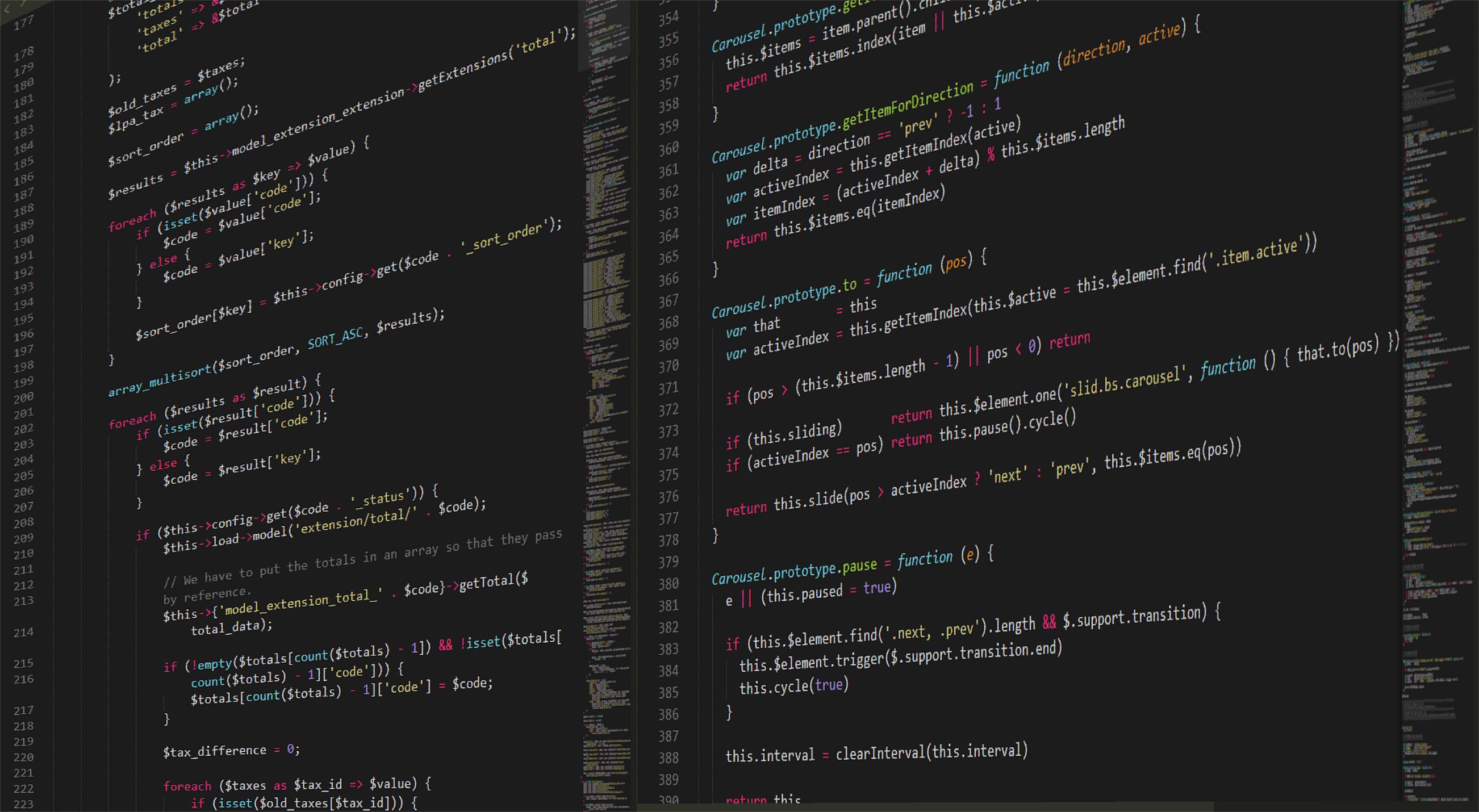
💼 Companies That Use .NET
A few of the companies using .NET as a programming language:
- Microsoft
- Starbucks
- Docplanner
- Stack Overflow
💵 Average Salary for .NET Developers
As of November 2021, .NET developers made an average of $94,124/year in the US.
🗺️ Where to Learn .NET: C# and .NET Core for Beginners on Udemy
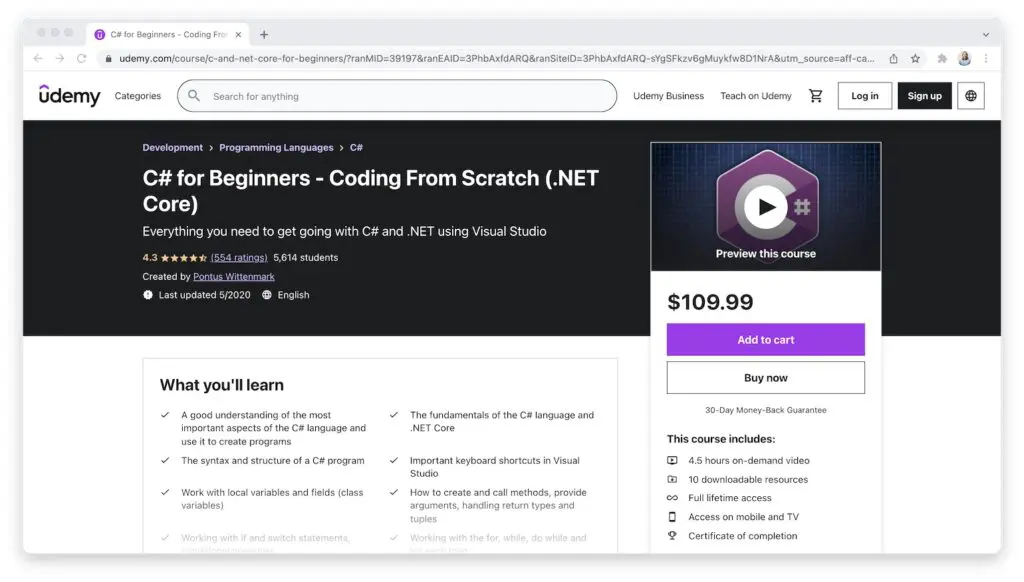
What the course covers: You’ll learn the fundamentals of the C# language and .NET Core — from the syntax and structure of a C# program to deploying .NET Core console applications, and much more.
Course facts:
- Course Name: C# and .NET Core for Beginners
- Platform: Udemy
- Instructed by: Pontus Wittenmark
- Price: $109.99
- Skill level: Beginner
Start coding now
Stop waiting and start learning! Get my 10 tips on teaching yourself how to code.
☝️ Back to top
Backend Language #4: Ruby
Ruby on Rails (or Ruby) is a web development language built on top of the Ruby programming language. Ruby on Rails has a set of tools that allow you to simply create basic tasks (e.g. you’re able to create a basic blog with one line of code).
Ruby involves little backend work, enabling developers to create and launch applications quickly. It is similar to Python in that it’s fantastic for prototyping. Ruby grew in popularity in the early 2000s as a result but has declined since then.
Ruby is open source, which means it can be modified and built upon.
Learn more about Ruby in the LTCWM guide.
💡 What You Can Do With Ruby
- Automate repetitive tasks
- Build web applications
- Build mobile applications and games
- Create prototypes
- And more
💼 Companies That Use Ruby
Here are some of the companies using Ruby as a backend language:
- Airbnb
- Codecademy
- TaskRabbit
- Kickstarter
- RapGenius
- Scribd
- AngelList
💵 Average Salary for Ruby Developers
As of November 2021, Ruby developers made an average of $115,515/year in the US.
🗺️ Where to Learn Ruby: Basics and Fundamentals of Ruby! on Mammoth Interactive
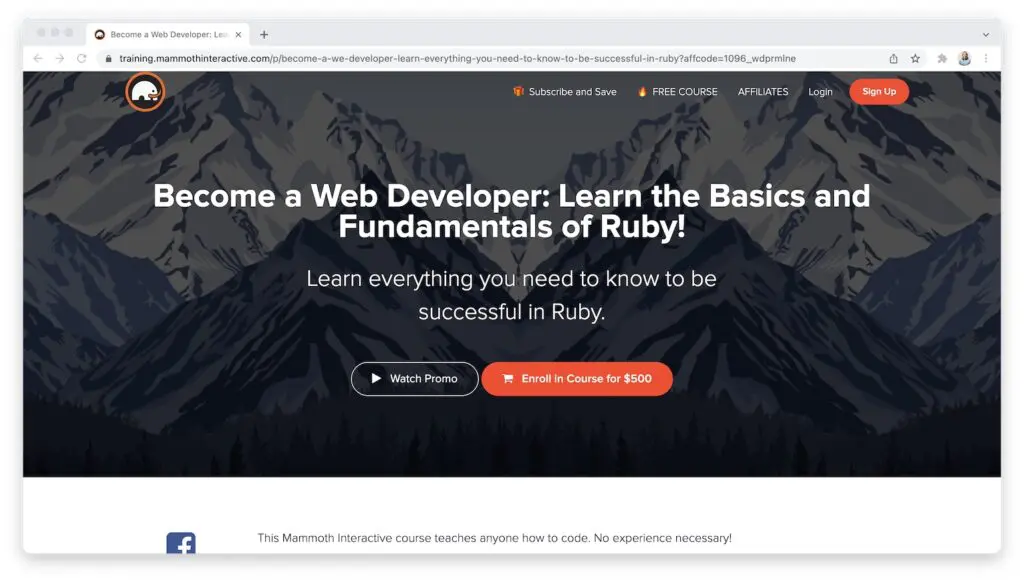
What the course covers: At the end of this course you will have real-world Ruby apps to use in your portfolio, even if you’ve never coded before in your life. Covers everything you need to know about Ruby.
Course facts:
- Course Name: Become a Web Developer: Learn the Basics and Fundamentals of Ruby!
- Platform: Mammoth Interactive
- Instructed by: John Bura
- Price: $500
- Skill level: Complete beginners
Start coding now
Stop waiting and start learning! Get my 10 tips on teaching yourself how to code.
☝️ Back to top
Backend Language #5: Python
There’s a reason Python is the fastest-growing programming language. The versatile backend language is used for both web and desktop development. Like with Java, there are plenty of tutorials and guides online, making it one of the more accessible back end languages for those just starting out.
Furthermore, its syntax is simple and easy to understand compared to other backend developer languages. Those who program with Python have lauded it for its “elegant,” “readable,” and “beautiful” code on Stack Overflow.

As mentioned above, Ruby and Python share similarities. They are both dynamically typed, open source, and object-oriented languages. The key differences between the two are the differences in popularity (Ruby is declining whereas Python is skyrocketing) and the tools in Ruby’s language.
Learn about the differences between Python 2 and Python 3 here.
💡 What You Can Do With Python
Some of the most popular uses for Python include:
- Cross-platform shell scripting
- Quick automation
- Simple web development
💼 Companies That Use Python
Among the biggest companies using Python as a programming language are:
- Uber
- Mozilla
- Spotify
- Quora
- Pandora
- Netflix
- Asana
💵 Average Salary of Python Developers
As of November 2021, Python developers made an average of $108,824/year in the US.
🗺️ Where to Learn Python: Complete Python Developer in 2022: Zero to Mastery
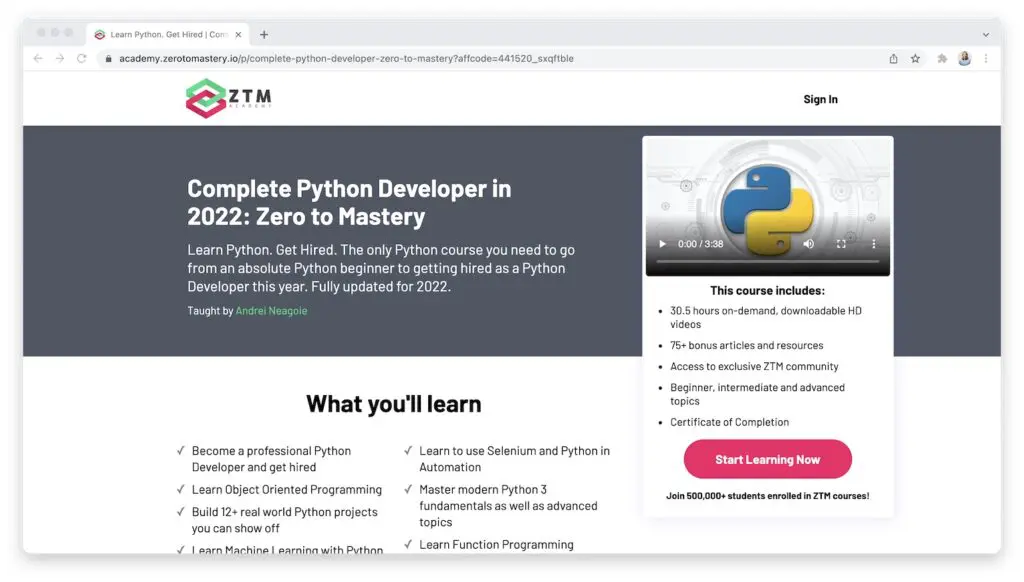
What the course covers: In this course, you’ll build 12+ real world Python projects you can show off, one of which is an actual portfolio website using Python that your future employer and customers can contact you at.
Course facts:
- Course Name: Complete Python Developer in 2021: Zero to Mastery
- Platform: Zero To Mastery
- Instructed by: Andrei Neagoie
- Price: $39/month with a Zero to Mastery subscription (or $279/year)
- Skill level: Beginners
☝️ Back to top
Backend Language #6: SQL
Structured Query Language or SQL (pronounced ‘sequel’) is the most common query language. SQL is used to interact with databases.
SQL is great for beginners to learn since it’s a declarative language. A declarative language allows coders to ‘declare’ the results they would like to see, without specifying the steps or process for said result.
A query language like SQL is great for those who want to take advantage of the wealth of knowledge stored in databases.
Learn more about SQL in the LTCWM guide.
💡 What You Can Do With SQL
SQL is used to access, manipulate, and create databases.
Those who work closely with data can benefit from learning SQL. This includes financial analysts, data-driven marketers, or online entrepreneurs. SQL is an ideal stepping stone for those who want to dive into the world of Big Data. For some inspiration, here is a list of jobs that use SQL the most.
💼 Companies That Use SQL
Since SQL is a query language, its use is broad and widespread. If a company or enterprise has a database, it is extremely probable that they are using SQL to query it.
💵 Average Salary of SQL Developers
As of November 2021, SQL developers made an average of $87,799/year in the US.
🗺️ Where to Learn SQL: Introduction to SQL on Pluralsight
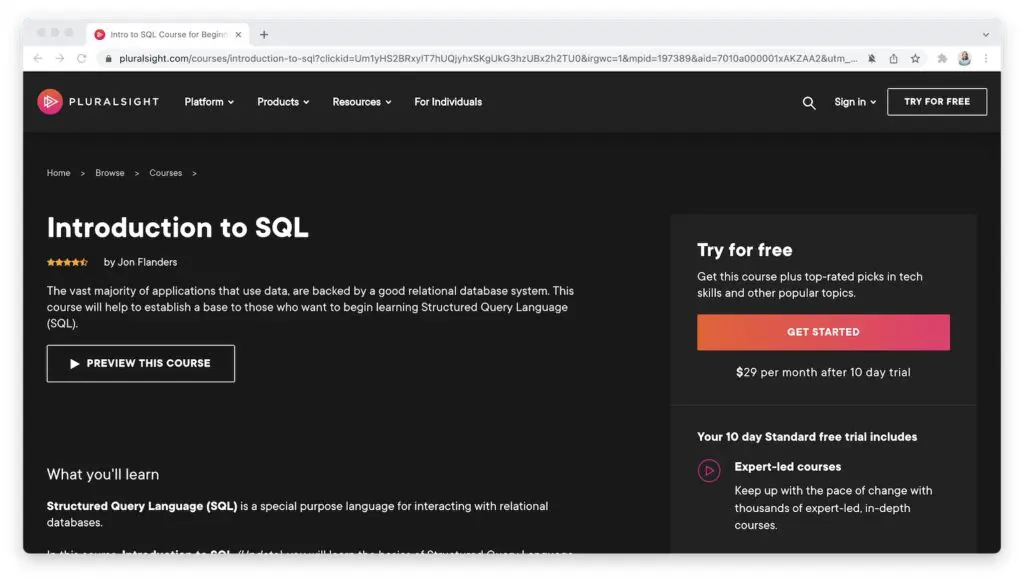
What the course covers: You’ll learn how to query data and shape results, create and modify data in tables, and learn how to actually modify tables themselves.
Course facts:
- Course Name: Introduction to SQL
- Platform: Pluralsight
- Instructed by: Jon Flanders
- Price: $14.92/month (or $179/year) with a Pluralsight subscription
- Skill level: Beginners
(Read our full review of Pluralsight here.)
☝️ Back to top
Backend Language #7: JavaScript
Not to be confused with Java, JavaScript is a language that can be used for both the front end and back end.
It’s a great language for beginners because it is a higher-level language and there is little setup involved (you can start coding in your browser).

Because the language is so flexible, objects created in this language are slow. It is also difficult to maintain and scale, as with most dynamically typed languages.
Having said that, the language is ubiquitous, which means the community is large—affording you a slew of resources and plenty of opportunities for employment if you know JavaScript backend technologies, such as Node.js.
💡 What You Can Do With JavaScript
JavaScript can be used to build many types of sites and software, including:
- Websites
- Mobile apps
- Desktop applications
- Games
- Web servers
- Presentations
- And more
💼 Companies That Use JavaScript
Famous companies using JavaScript include:
- Airbnb
- Codecademy
- HotelTonight
- eBay
- Square
- Asana
💵 Average Salary of JavaScript Developers
As of November 2021, JavaScript developers made an average of $110,591/year in the US.
🗺️ Where to Learn JavaScript: Coding for Cats on Mammoth Interactive
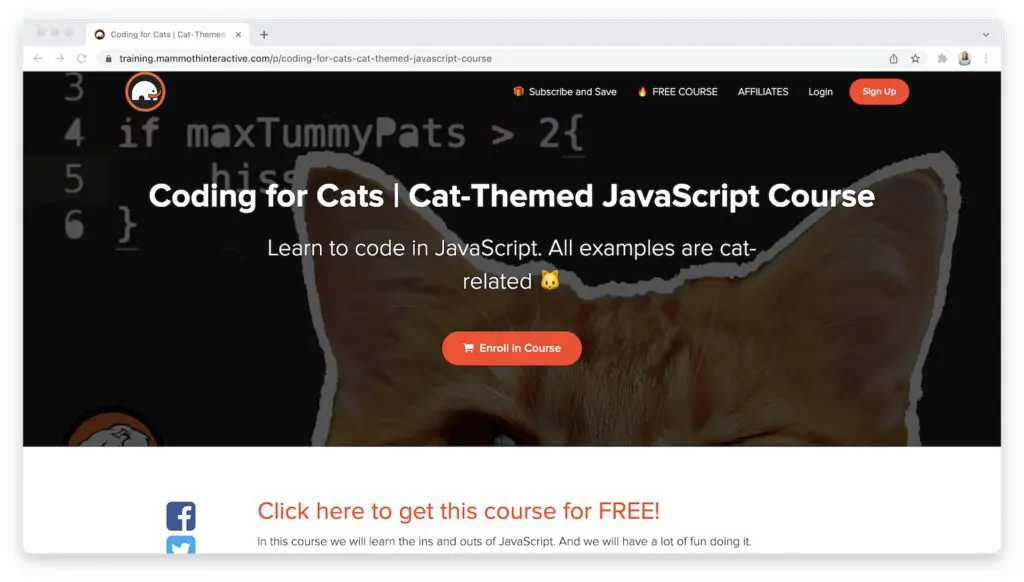
What the course covers: A (cat-themed!) crash course in learning to code in JavaScript (with cat-related examples).
Course facts:
- Course Name: Coding for Cats | Cat-Themed JavaScript Course
- Platform: Mammoth Interactive
- Instructed by: John Bura
- Price: $99 or $19/month for all courses on Mammoth Interactive
- Skill level: Beginners
🗺️ Launch School’s Introduction to Programming with JavaScript ebook
What the course covers: This free ebook will provide you with a solid foundation in general programming and problem solving with a programming language, and teach you modern web application development from the ground up.
Course facts:
- Course Name: Launch School’s Introduction to Programming with JavaScript
- Platform: Launch School
- Price: Free
- Skill level: Beginners
For even more places to learn JavaScript, see my roundup of the best JavaScript courses.
☝️ Back to top
Backend Language #8: TypeScript
TypeScript is an open source “superset” of JavaScript that builds on JS’s foundation so you can develop higher-quality, less buggy code. It was developed by Microsoft to simplify JS code. It can be used in the backend with other JS technologies like NodeJS and Express.
According to Stackoverflow’s 2021 Developer Survey, TypeScript is the 7th most used programming language, with 30.19% of respondents saying they use it. TypeScript is an object-oriented programming language whereas JavaScript is a scripting language.
If you already know JavaScript, TypeScript should be fairly easy to learn!
💡 What You Can Do With TypeScript
- Make code easier to read and understand
- Create dev tools for JavaScript IDEs and practices
- Speed up development
- Make JavaScript programming more reliable
💼 Companies That Use TypeScript
Top companies using TypeScript include:
- Slack
- Accenture
- Medium
- DoorDash
- Canva
- Walmart
💵 Average Salary of TypeScript Developers
TypeScript developers make an average of $130,000/year in the US.
🗺️ Where to Learn TypeScript: Learn TypeScript on Codecademy
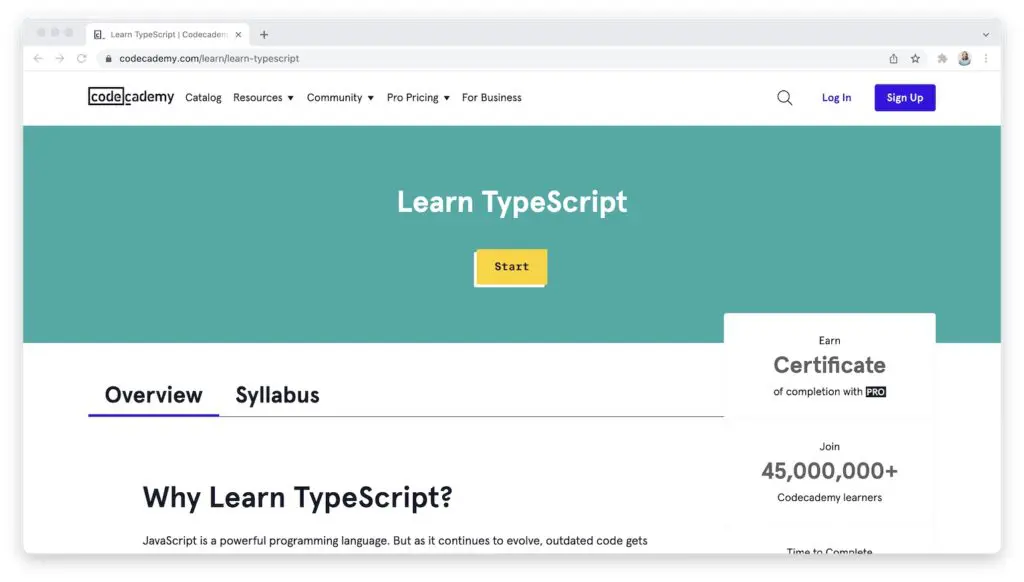
What the course covers: You’ll learn how to apply JavaScript syntax to TypeScript’s type system. This will help you build your own programming experience and give your code more structure. You’ll also learn how to use TypeScript’s linter to reduce compilation errors and speed up workflow.
Course facts:
- Course Name: Learn TypeScript
- Platform: Codecademy
- Price: Free ($19.99/month to get a certificate of completion)
- Skill level: Intermediate (must be familiar with JavaScript)
(Read our full review of Codecademy here.)
☝️ Back to top
Backend Language #9: Go
Also referred to as “Golang,” Go is a statically typed, compiled programming language created by Google. It was released to the public in 2009. Its syntax is similar to C/C++, but Go also provides memory safety, garbage collection, and other features that make it great for backend programming. It also makes code more readable than C does, like Python or JS.
Go is a fast backend programming language since it can translate its source code to machine code in its own compiler. It also has a feature that simplifies the bug identification process.
💡 What You Can Do With Golang
- Build web applications
- Server-side development
- Cloud-native development
- Machine learning applications
💼 Companies That Use Go
Top companies using Go include:
- Uber
- Shopify
- Robinhood
- Twitch
💵 Average Salary of Go Developers
Golang developers make an average of $131,625/year in the US.
🗺️ Where to Learn Go: Programming with Google Go Specialization on Coursera
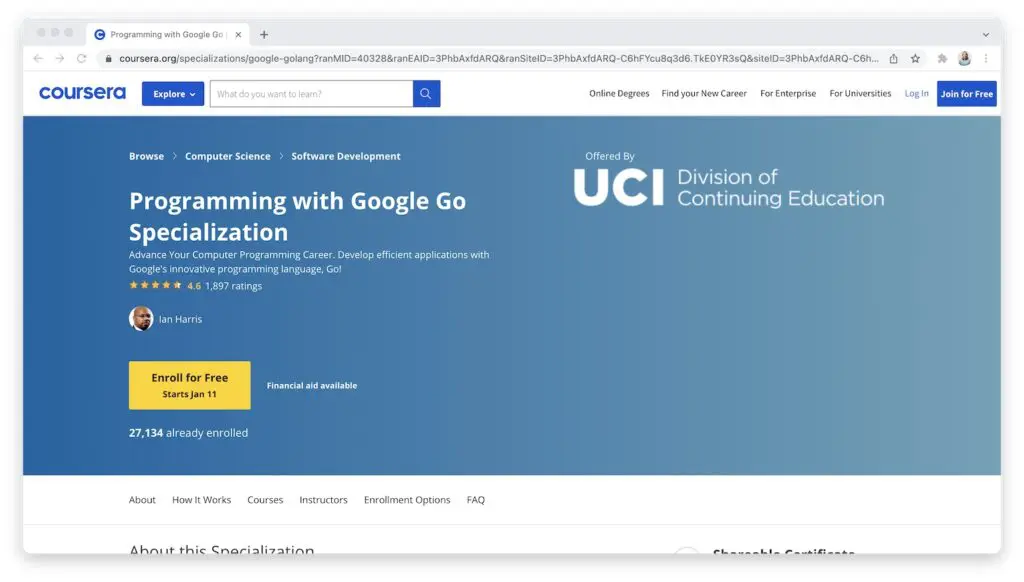
What the course covers: In this 3-course specialization, you’ll learn the basics of Go, including topics like data types, protocols, formats, and writing code that incorporates RFCs and JSON. You’ll have an opportunity to create your own Go applications so you can practice what you’re learning.
Course facts:
- Course Name: Programming with Google Go Specialization
- Platform: Coursera
- Price: $49/month (or free to audit)
- Skill level: Intermediate (must have previous programming experience)
☝️ Back to top
Other Backend Skills To Know
As you start to learn backend development, here are some other backend skills you may need that are not programming languages.
Backend Skill #1: Databases / and Cache
As a backend developer, it can be helpful to understand how databases and database caching works. Caching is a technique that stores frequently-queried data in a temporary memory. It supplements a primary database by removing unnecessary pressure on it.
Many backend job descriptions require knowledge of Database Management Systems (DBMS), such as MySQL, PostgreSQL, Microsoft Access, SQL Server, and caching mechanisms like Redis and Memcached.
Backend Skill #2: Web servers
A web server is software and hardware that uses HTTP (Hypertext Transfer Protocol) and other protocols to respond to client requests. As a backend developer, you may need to know production web server technologies such as load balancers (e.g., Nginx and HTTP proxies.
Backend Skill #3: API (REST & SOAP)
APIs, Application programming interfaces, allow two separate applications to talk to each other. They play a role in how most server-side software architectures are built.
Two API styles you might come across as a backend developer are SOAP and REST. SOAP stands for Simple Object Access Protocol. REST stands for Representational State Transfer.
Start Taking Courses to Learn Backend Development!
In this overview, I hope you were able to get a clearer picture of backend development and the capabilities of each language included. This is by no means an exhaustive list of the backend languages that are out there. If you’re interested in learning more, Learn to Code With Me and GoSkills have easy-to-understand resources to guide you further.
If you are considering pursuing a career as a back end web developer, I would highly recommend taking a look at the job descriptions of the roles you’re interested in and make a note of the backend languages that appear the most. Then, learn backend development languages and skills using courses like the ones highlighted above.
Don’t let the industry jargon scare you. Remember that an expert at anything was once a beginner too.
About the Author

Krystal does all things Marketing at GoSkills. When she’s not at work, you can find her listening to podcasts or watching comedy specials on Netflix. GoSkills is an online learning platform that helps anyone learn business skills to reach their personal and professional goals.
